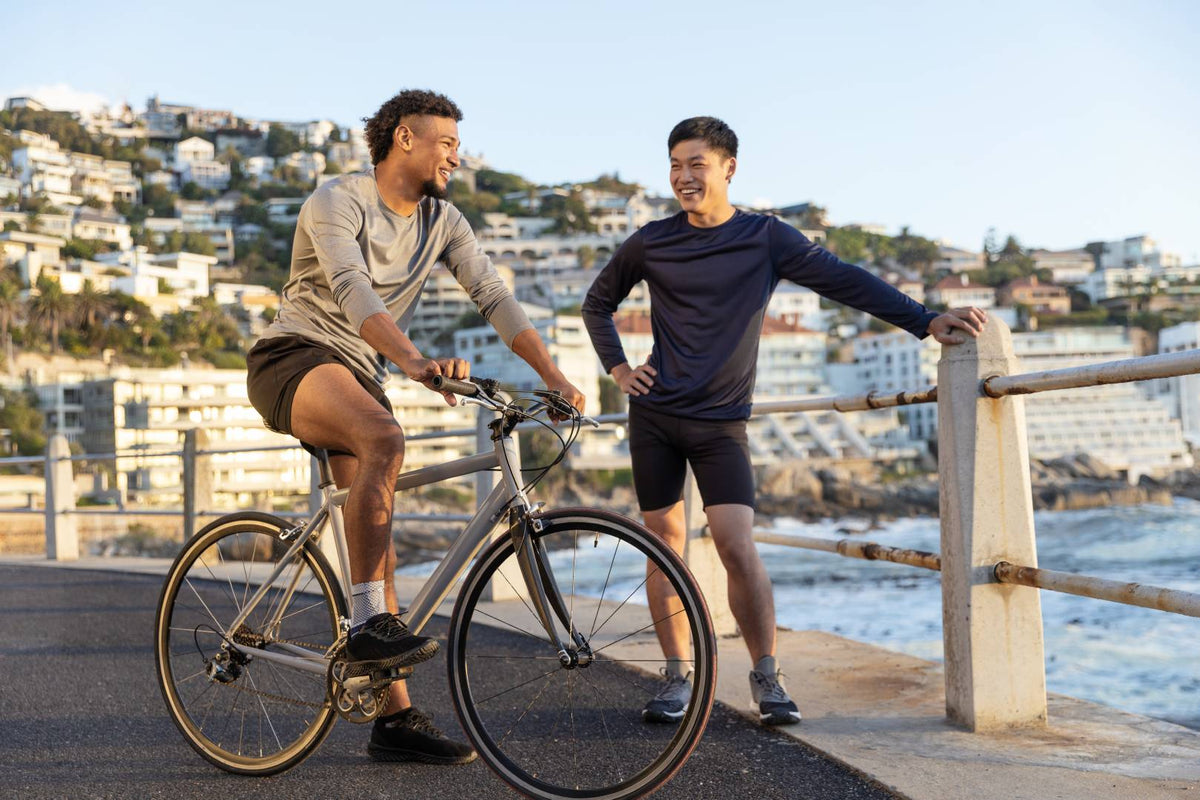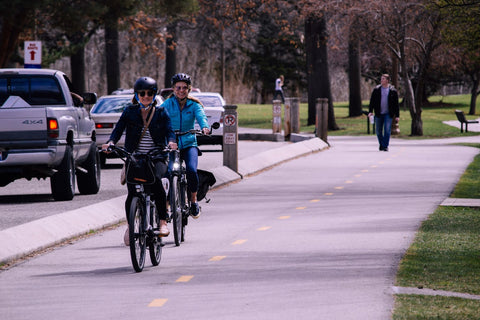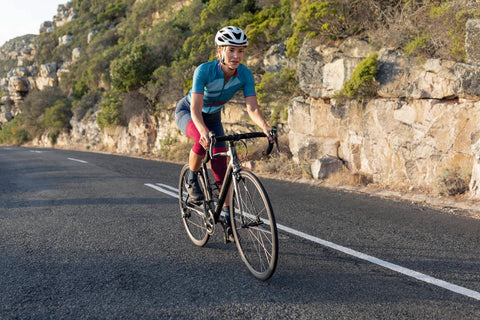Cycling Tips for Beginners

Are you getting back into cycling or learning for the first time? Either way, you’ll need some cycling tips for beginners. So, here’s our breakdown of everything you’ll need to know about gear, routine, roadways, and maintenance.
Get a good bike
You can practice riding on just about any bike - from a tiny kids’ bike to a decked-out road one built for speed. But getting a bicycle that fits you and suits you well will make you enjoy the learning experience much more. You’ll get fewer wobbles and crashes - and a comfortable ride. We recommend heading to a dedicated cycling store near you for accurate measurements and advice.
We’d also recommend researching the kind of bike you want. Road bikes have a lot of gears to learn and a high seat for minimum wind resistance. While they’re great for speed, they’ll be unstable on country roads and may feel uncomfortable for first-time riders. Mountain bikes are great for forest trails and are more comfortable to sit on, but their thick, highly textured wheels might feel slow on smooth roads. Generally, fitness bikes are the best of both worlds. They’re intended for multi-purpose riding and won’t have 100 gears to switch between.
Lastly, test out the seat. Unfortunately, a bit of discomfort is expected with bike seats. But if your butt hurts after a few minutes of sitting, pick and test out another one.
Note: reduce discomfort further by getting a pair of padded bike shorts.
Find a safe place to practice

If it’s your first time on a bike, practice somewhere with few obstacles (cars, trees, mailboxes, etc.) and ride on wide, straight paths. And if you do wobble, run into something, or keel over to the side, don’t stress too much. These are all part of the learning experience. Even if you have ridden a bike before, avoid busy roadways and forest trails while you’re getting back into the sport.
Get the right gear
You’ll also need some essential bits of gear to stay safe on the roads. These include:
- Helmet
- Bike lights (crucial for night and low visibility riding.) If you’re going to cycle through foggy weather, you should also consider some reflective strips or a high-vis vest.
- Accessories. A water bottle clip can come in very handy on long rides.
In terms of clothing, you won’t need an aerodynamic fit (unless you’re into that sort of thing). A simple pair of leggings and a tighter-fitting shirt is enough. You do want to consider the length of your clothing - long pants protect the knees better from scrapes than shorts do. You should also avoid flappy or loose-fitting pants, which can get caught in your bike gears and result in crashes.
Try a compression sleeve or two

Sports Compression Knee Support
As a beginner, you’re probably not looking for a way to maximise your cycling performance. But compression garments also have several benefits for beginners:
- They boost circulation. When you do physical activity, your heart typically won’t have trouble shooting blood through the arteries, but the veins can struggle to keep up. This is why a strenuous exercise like weightlifting can make veins protrude much more than normal. Compression garments like our Sports Compression Calf Sleeves boost the rate of venous return, keeping veins from overflowing, thus freeing up space in your tissues for oxygen and nutrient-rich arterial blood.
- Compression garments also reduce muscle aches and fatigue. Your low back will be especially at risk as you get used to the flexed seating position. Our Sports Back Support will activate your core muscles to protect your spine better. It will also relieve low back pain through its specialised gel pad.
- Reduce the impact of DOMS. If you’ve ever tried a new sport, you know the following day can be a very stiff and painful one. Because compression garments help your muscles get the oxygen and nutrients they need, they speed up the muscle repair process, reducing next-day soreness.
There are plenty of compression options to choose from, depending on what you need on your rides. Compression Arm sleeves can reduce arm fatigue from leaning on your bike handles, and Sports Performance Socks build on what’s offered by the calf sleeves by also covering and supporting the foot as you pedal along.
Learn more: Top 3 things a Knee Compression Sleeve Can do for You
Beginner cyclists should always start easy
Cycling for fitness is no extreme sport, but you can still take on too much too soon. Picking up too many hours of physical activity can lead to muscle fatigue, cramps, and even overuse injuries like Iliotibial Band Syndrome and Patellar Tendonitis.
So, follow the 10% rule. If you start with 90 minutes of practice rides in a given week, add another 10 minutes the following week. This way, you’ll still get plenty of cycling in without putting too much strain on your muscles and tendons.
Keep your bike in good shape

You won’t need to fuss over your new bike for hours at a time but don’t just chuck it into your garage and forget about it till you need it again. Bikes need a certain level of care to stay in one piece and keep riding easy.
- Wipe the frame and wheels down if wet. Rust is a bicycle killer. Don’t let it get to yours.
- Keep an eye on the tire pressure. Long hours of practice can start deflating the wheels, leading to a wobbly, accident-prone ride.
- Lubricate the chains. This step will help them run smoothly and keep switching gears easy.
- Check your brake function and chain wear and tear before you ride.
- Get replacement parts if necessary. The beauty of bikes is that you can take most things out and put replacements in - wheels, handles, accessories, pedals, seats, the works. If you feel like a part of your bike isn’t functioning well or just isn’t to your liking, replace it. It’ll save you a lot of pain down the line.
Learn more: 10 essential bike maintenance tips for beginner cyclists
To sum up
For a better learning experience (and to increase your likelihood of sticking with the sport), you shouldn’t just grab any old bike and start riding. You need to keep some cycling tips for beginners in mind. Invest in a decent bike that suits your body type and needs, get the right cycling gear, and don’t take on too much too fast.
Explore more cycling supports: Cycling Braces & Straps
If you require assistance selecting the right product for your needs or wearing the brace, call us on 1300 668 466 or contact us via live chat.
Do you have private health? Most private health extras will cover Bauerfeind Products. Check to see if yours is included. Bauerfeind Private Health Insurance Inquiry.


